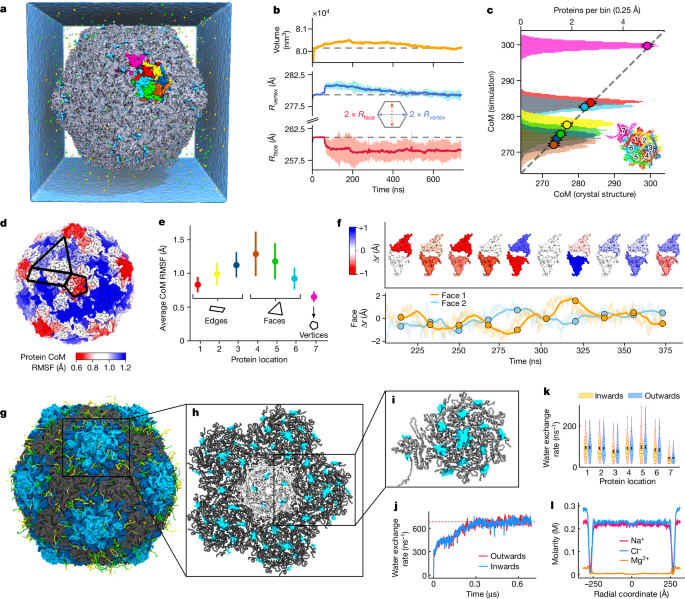Unveiling the Structure of a Packaged Bacteriophage Particle
Основные понятия
The author explores the three-dimensional organization of viral genomes within a protein capsid, revealing insights into DNA packaging mechanisms and potential drug targets at the genome-capsid interface.
Аннотация
A detailed study delves into the structural models of an HK97 virion, encompassing its entire genome loaded into a protein capsid through simulations. The research uncovers the loop extrusion mechanism for DNA packaging, highlighting unique configurations of viral particles and their impact on capsid structure, internal pressure, and diffusion dynamics.
The structure and physical properties of a packaged bacteriophage particle - Nature
Статистика
The entire 39,732 base pair genome was included in the model.
A 26 million atom model of the complete virion was produced.
Multiple microsecond-long all-atom simulations were conducted.
Цитаты
"Our approach can be generalized to obtain complete all-atom structural models of other virus species."
"DNA packaging occurs through a loop extrusion mechanism that produces globally different configurations of the packaged genome."
Ключевые выводы из
by Kush Coshic,... в www.nature.com 03-06-2024
https://www.nature.com/articles/s41586-024-07150-4
Дополнительные вопросы
How does understanding the structural imprints of capsids onto genomes aid in drug development
Understanding the structural imprints of capsids onto genomes is crucial for drug development as it can reveal new potential targets at the genome-capsid interface. By identifying specific interactions between the viral genome and capsid proteins, researchers can design drugs that disrupt these essential connections, thereby inhibiting viral replication or assembly. This knowledge allows for the development of targeted antiviral therapies that specifically interfere with virus assembly processes without harming host cells. Additionally, by elucidating how capsids influence genome structure and function, researchers can uncover vulnerabilities in the virus life cycle that can be exploited for therapeutic purposes.
What are potential limitations or challenges in applying this research to other virus species
While this research provides valuable insights into the packaging mechanisms of bacteriophages like HK97, there are challenges in applying these findings to other virus species. One limitation is the diversity among viruses in terms of their structures, genomic compositions, and packaging mechanisms. Each virus may have unique features that require tailored approaches to study their interactions between genomes and capsids accurately. Furthermore, experimental techniques used to investigate one virus may not be directly transferable to another due to differences in size, shape, or behavior at a molecular level. Therefore, adapting this research to different virus species would necessitate extensive characterization studies and potentially novel methodologies.
How might advancements in virology impact broader fields such as nanotechnology
Advancements in virology have significant implications beyond understanding viral infections; they also stand to impact broader fields such as nanotechnology. The detailed structural models obtained through all-atom simulations offer insights into complex biological systems' organization on a nanoscale level. These findings could inspire innovations in nanotechnology by providing blueprints for designing nanostructures with precise control over composition and function mimicking natural biological systems like viruses but engineered for specific applications such as drug delivery or materials science.
0
